SPANGDAHLEM AIR BASE, Germany -- The two most memorable moments of U.S. Air Force Chief Master Sgt. Edwin Ludwigsen’s, 52nd Fighter Wing command chief, military career oddly involved him exiting his father’s car.
The first occurred when he parted ways with his father before boarding a bus in Spring Lake, North Carolina, headed to U.S. Air Force Basic Military Training at Lackland Air Force Base, Texas, Feb. 9, 1995.
“Recruiters back then didn’t waste any time,” Ludwigsen said. “I went into the recruiter’s office on February 5, and on February 9, I was heading out on a bus; they put me right in.”
Fast forward 21 years, the second moment took place on a familiar North Carolina country road when Ludwigsen received a phone call from U.S. Air Force Col. Joe McFall, 52nd FW commander.
The big news: McFall selected him to serve as the wing’s next command chief.
“Just the colonel telling me that he was bringing me out here and getting to share that moment with my dad was the most memorable moment of my career,” Ludwigsen said. “We celebrated with a big steak dinner.”
Those two departures – also involving Airmen of higher rank calling upon him to serve – represent bookends to a continuing career that would take Ludwigsen – who prefers to be called “Chief Lud” – from an airman basic to assuming the top enlisted role at Spangdahlem Air Base, Germany, May 22, 2016, from outgoing command chief U.S. Air Force Chief Master Sgt. Brian Gates.
Ludwigsen, who previously served as superintendent of the 86th Logistics Readiness Group at Ramstein Air Base, Germany, comes to Saber Nation with a set of priorities and an assessment for his fellow Airmen rooted in more than 21 years of experience in uniform, as well as a lifetime of experiences from his family upbringing in North Carolina.
“The welcome has been phenomenal from the moment we arrived,” Ludwigsen said. “The sense of community and everybody’s welcome – we really appreciate it. Krista, I and our girls definitely see why everyone told us we got the best assignment in the Air Force.”
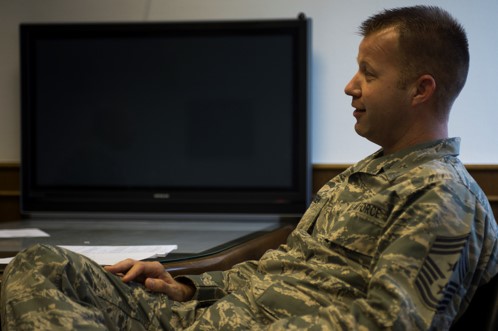
“When I grew up, the value was my family.”
His new home in Saber Nation is just hours away from his place of birth at the U.S. Army’s Lee Barracks in Wiesbaden, Germany. Ludwigsen never had the chance to return to Germany until his first assignment in this country in June 2012.
The son of U.S. Army Staff Sgt. Edwin Ludwigsen, both Ludwigsen and his father not only hold the same first and last name, they both share the same date of birth as with his grandfather – August 22. For the Ludwigsen family, the family roots run deeper than designations, times or places.
The elder Ludwigsen soon moved from Germany to Spring Lake, North Carolina, which would later become the family’s home location fixed between Pope Air Field and Fort Bragg. The command chief attributes his straightforward nature to his upbringing, cultivated by a work ethic instilled by his mother and father and the economic realities of their situation.
“We didn’t go out and do a whole lot because we didn’t have the money for it,” Ludwigsen said. “I think that kind of shaped why I value the things that I do. I had a mom and dad with morals and values who taught me right from wrong and held me to a high standard. My dad was very disciplined, rigid and worked me to the bone.”
That emphasis on ‘work’ didn’t leave room for other childhood luxuries—one of his first childhood memories was his father handing him a tool set to take apart lawn mower engines and put them back together.
That hardware he received would also come with lessons he would learn the hard way spending much of his youth not at county fairs or on road trips but in doing mechanical and yard work on soil firmly stamped down upon by the Tar Heel state.
“When I grew up, the value was my family, being together and taking care of each other,” he said. “Through my time in the Air Force, I’ve been able to resonate with the community and taking care of our Airmen. As a chief, that’s what I do; I just want to take care of people. If I can get in a circle and see a problem that’s impacting our Airmen and help affect change and do away with that problem; that’s what I want to do.”
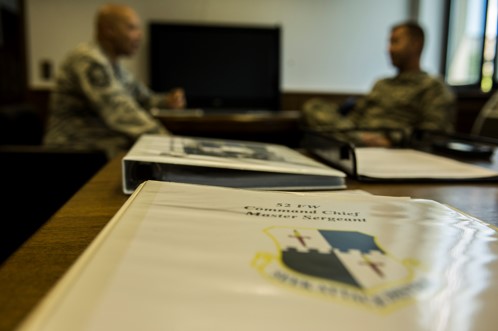
“You call this ‘work’? This is fun!”
The newly-minted Airman Ludwigsen soon became a fuels apprentice after technical school training at Sheppard Air Force Base, Texas, in June 1995.
Reflecting back on his early career, now-Chief Ludwigsen remarked on how much he relished doing what he loved back home and now being paid to do it.
“The physical work of the Air Force was nowhere near as difficult as the physical work I did growing up,” he said. “You put me in a big truck on the flightline, driving around awesome airplanes and I was like ‘You call this ‘work’? This is fun!”
His early days in the Petroleum, Oil and Lubricants flight – often referred to as “POL” with pride – was punctuated by cashing paychecks, but he said the time around when he received a line number for technical sergeant soon translated to deeper changes in Ludwigsen’s reason for national service. Ironically, it also came when terms like “stop loss” dominated service member’s enlistments, just as it did for his.
“All the way up to that point, it was a kind of a job—I enjoyed it, I was good at my career and being the best Airman I could be, but it still was more of a job,” he said. “After that, I had to make a decision, and it was really based on the camaraderie and experiences of several deployments where I started to understand and see firsthand the value in what we do and why we do it. You see how it takes a team to execute the mission and that is when I realized ‘This is me, this community, this family, this is what I want to be a part of.’”
That spark first formed in the deserts of the Middle East later transferred to his career. In 2004, he attended NCO Academy in Goodfellow Air Force Base, Texas, and ended the year as NCO of the Year for the 97th Mission Support Group, Altus Air Force Base, Oklahoma.
Ultimately, that’s when Ludwigsen said his attitude changed from “This is a paycheck,” to “This is more than a job now – I get it.”
He also attributed his time working as superintendent of Fuels Resource Automation and Energy Conservation at the Pentagon as affording him a graduated view from tactical and operational to the strategic perspective of Air Force operations.
“I wanted to be a chief to have a seat at the table and have some fingerprints on what the Air Force of tomorrow is going to look like,” he said.
In December 2012, Ludwigsen accomplished that goal, having sewn on his eighth chevron, entering the Air Force’s top one percent of the enlisted force. He said one of the lessons from his professional military education he closely adheres to refers people’s level of commitment and how that often reveals about their character more than their abilities.
“You can almost plot out how my commitment level has changed,” he said. “I can look at the levels where I was in as an airman basic to get a paycheck. As a tech, it was to be a part of something bigger than myself. Now, as a senior NCO and a chief, I stay to take care of other people and because it’s an honor to serve.”
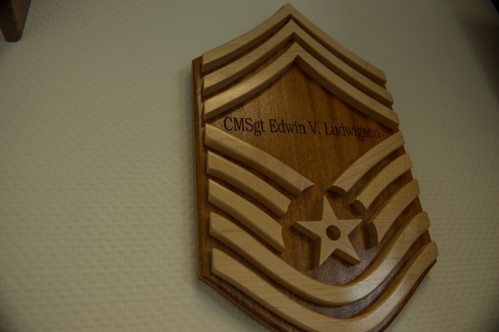
“Expertise—Energy—Effort”
The transition from Ramstein to Spangdahlem involved more than a trip on the Autobahn and getting new insignia sewn on all of his uniforms. The job would come with Ludwigsen leaving his imprint on others around him.
And his first impression involved a triple threat ground around his first name.
“As a Group Superintendent, my Commander and I developed our three ‘E’s’ that I still carry with me today,” he said. “‘Expertise’—we’re all trained experts. Our Airmen are the best in the world, and it is important that we continue to master and hone those skills. Then give me some Energy and Effort! So you’ll routinely hear me asking my Airmen to give me Energy Effort and Expertise; that’s what I’m looking for from our Airmen.”
Ludwigsen also said those three E’s intersected with his role as a command chief and as a 24/7 Airman.
“My hobby is taking care of Airmen; my hobby is the Air Force; and my hobby is my job,” he said. “It’s pretty cool I can say that. It’s the truth.”
“Communication is still an issue today.”
Now donning the additional star on his sleeves, Ludwigsen took aim at what he calls one of the biggest challenge and opportunities facing the Air Force today: communication.
The deployment lengths and distances may not have changed as much since when he first enlisted, yet any chasms or barriers to communicating since then have been narrowed to by technology and accessibility.
“When I first deployed, you were lucky to get one 15-minute morale call,” he said. “Now we’ve got things like Skype, Facebook, and we can email anyone at any time. Our connection and communication now compared to when I deployed as an Airman is far superior to what it was 20 years ago.”
Any development in communication can sometimes dilute the importance of relating the message between human beings and allow context to get lost, he said. As leaders, we can’t lose sight of the importance of analog leadership; we have to get out from behind the desk and establish meaningful relationships with our Airmen if we expect to understand their challenges and help them.
“I’m focused on removing some of the communication barriers we are still facing with the changes to the Enlisted Evaluation System. We’re going through the most significant Enlisted Evaluation System changes that I’ve seen in my time in the Air Force,” he said. “It’s not that they’re not valuable—they’re very valuable and are very necessary changes -- but we, as an institution, still have work to do with respect to communicating these changes to our Airmen and so they can understand its value and start to reduce the stressors associated with these changes.
As the command chief, Ludwigsen said he intends to get out his comfort zone – up until his first day as the command chief, he never had a profile on any social media platform – to open his aperture he plans to step into the social media world as another way of communicating with and, more importantly, listening to his Airmen.
“If we could communicate the need for change as well as we’ve improved the communication to keep in touch with our family when we’re gone, we’d be getting somewhere,” he said. “We’ve got to work on that, and now I see myself in a role where I hope to improve communication with our Airmen.”
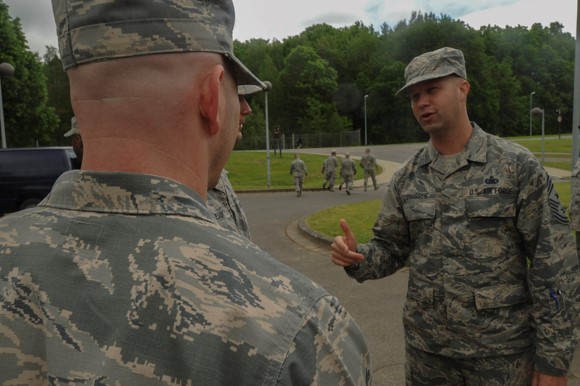
“I know I’m not perfect.”
Ludwigsen’s observations on the current EPR system also reflect the difference between how supervisors handled feedback when he first joined and now.
“Honestly, I probably am a product of not receiving a lot of good feedback, which is why I stress giving good feedback,” Ludwigsen said. He qualified that from his relationship between his father and past supervisors: if they asked him to do something, he did it without question.
But he felt the relationship ended there—as well as the potential opportunity for both he and his supervisors to get better from criticism, too.
“I know I’m not perfect,” Ludwigsen said. “I’ve been a ‘firewall 5’ my whole career—but I’ve not been a ‘firewall 5’ Airman my whole career. I haven’t done everything perfect my whole career—I got in trouble and received paperwork in my career. I wasn’t the exemplary Airmen the form is saying I am, but I’ve never been marked down. I often wonder how good I could have been had I received critical feedback, but we just didn’t do it.”
He admits the present situation may be harder for Airmen to accept, but he remains open and insists on feedback across the wing to make it the strongest it possibly can be.
“It’s important,” he said. “Who knows what I could have been had someone told me how I could be a better Airman.”
“Taking care of your Airmen sometimes means saying ‘no.’”
Ludwigsen also said his priorities even included challenging a perception behind what “taking care of your Airmen” can really mean.
“Don’t forget that taking care of your Airmen sometimes means saying ‘no’,” Ludwigsen said. “I’ve got three touchpoints when you look at decisions in the Air Force: your Airmen; the organization, like the squadron or group or wing; and the Air Force as an institution. When I’m making a decision about my Airmen, I’m thinking about those three levels.”
The chief said Airmen may want to do something or make a request, which may sound good, but may run counter to those three touchpoints.
“I want to help my Airmen,” Ludwigsen said. “But the answer may be ‘no’ because it may jeopardize the organization or the Air Force as an institution. We have to think about those things. Those three touchpoints have to always be considerations in our decision-making.”
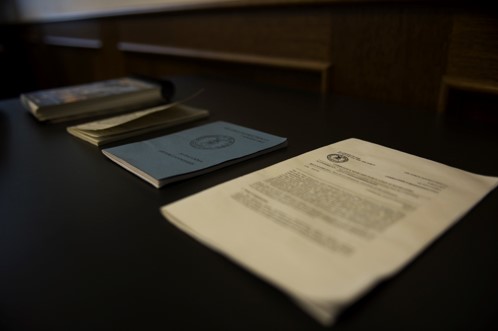
“That’s why I’m here.”
In his first month as the command chief, Ludwigsen has made the rounds to greet Airmen at different squadrons, selected music for the American Forces Network Spangdahlem’s radio show – at least, his family did when they requested Taylor Swift and Tom Petty – and even participated in the unveiling of the Saber Pet Lodge at its new location.
But he said it’s his exclusive hour with brand new Airmen at the First Term Airmen Center that solidified his approach to what he hopes will be his legacy.
“These are brand new Airmen who don’t know me, they’re going to be nervous when they come in contact with me, but I need them to view me as approachable and have them remember me for that,” Ludwigsen said. “If I’m approachable and you’ll come talk to me, we can have that conversation, then I can help. If I’m not approachable, I never know what you need and I can’t help you.”
That approachability is also a goal he hopes his fellow Spangdahlem Airmen will apply whenever they see him.
“If you see me in the BX, ask me how I’m doing, because I might be having a rough day,” he said. “I’m going to ask you how you’re doing, and I want to know how I can help you. I’d want to think if someone saw me walking out of the BX, and they needed a ride across the base, they would ask me for a ride. It’s not always about being something big—if Airmen and people will come to you and talk to you and know you’re sincere and approachable, there’s an opportunity to help them if they need help. That’s why I’m here.”
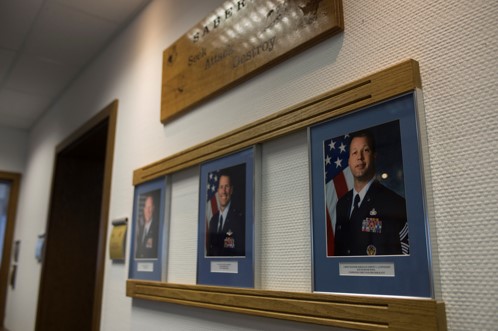
“I was able to jump in and get back to work.”
Perhaps the best person to ask the question why Ludwigsen received the command chief billet at Spangdahlem is the commander.
However, the answer, truly, resides with the command chief and what he does with it.
“He chose me based on a personality, a skillset and a background he thought could help move the wing forward,” Ludwigsen said. “I think I’m a command chief based on my work ethic, my ability to communicate, my openness and a product of good timing. It’s definitely not because I’m any smarter or better than anybody else or anything like that. Just supervisors seeing things, pushing me forward and saying ‘you probably can operate in that capacity at the next level, and I just continue to try to be the best Airmen I can be. I’m just honored to be able to continue to serve our Air Force.”
As he heads to work each day in Building 23, Ludwigsen will pass by the photos of his predecessors, which are displayed on the wall leading to his current office.
In due time, there will be a section reserved for him, where his photo will be displayed, too.
And in passing those photos, his mind may go back to both of those memorable moments in his father’s car when he transitioned—first from a civilian to an Airman and then from chief to command chief-select—and how he would finally arrive at Saber Nation.
Who knows? In a few years, Ludwigsen may establish the third most memorable moment of his career when he and his father and family drive off, leaving behind a new Saber Nation to his successor and the future Airmen of Spangdahlem Air Base.
But until that day comes, Chief Lud has a job to do today.
“That star represents a responsibility to establish good order and discipline as well as to not let down the position of those before and after me,” he said. “I was nervous because I don’t want to let the command chief position down or the boss. But as soon as I got here, the nerves went away—I was able to jump in and get back to work—I feel like the luckiest Airman in the Air Force.”